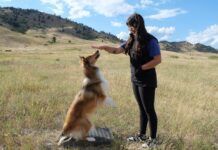There are some things our dogs do that are a complete mystery to many of us, especially when it’s a behavior we’ve never seen before. To me, one of the strangest is blanket-sucking (or blanket-chewing, depending upon the dog). In all the dogs I’ve had and known, I’ve never seen this behavior before so from my perspective, it’s totally inexplicable.
And yet, there is an explanation. Rather, several explanations.
What IS This Sucking Behavior?
We’ve all seen human babies sucking on pacifiers, their thumbs, or even on blankets and child experts tell us that this kind of instinctive sucking calms babies and makes them feel more secure. The same is likely true for puppies, who are born with an innate need to suckle and knead. Even after the mother dog has long since stopped producing milk, some pups will attempt to suckle, perhaps as a way to soothe themselves.
In addition, puppies will often look to something similar to their mother’s soft skin and fur for comfort: something like a supple, velvety stuffed toy or blanket. Most of the time, a puppy will grow out of this behavior, but what happens if it doesn’t? What happens if your adult dog continues to knead her old threadbare blanket or suck on her ancient stuffed hippopotamus? Should you be worried that you’ve inadvertently created an canine psychoneurotic?
Is Blanket Sucking a Harmless Behavior?
The answer in most cases, there’s nothing inherently wrong with an adult dog who is still mouthing and kneading her blanket or toy. We’ve all had dogs that choose one particular stuffed toy as their inseparable companion: years ago, my dog Casey claimed a stuffed penguin that he carried around everywhere, even to the construction site of the house I was building where it got run over by a tractor, dropped in a culvert, smeared with concrete, and buried in three feet of dirt . . . yet even then, even when it was totally dilapidated, he refused to give it up.
Gwen Bailey, author of more than a dozen books on dog behavior and member of the U.K.’s Association of Pet Behaviour Counsellors, says this kind of “object-sucking” is usually quite harmless, the canine equivalent of a toddler who inexplicably latches onto a favorite “blankie” and carries it everywhere. She explains that while this behavior in adult dogs isn’t terribly common, it’s not deviant by any stretch of the imagination; it’s also not breed-specific, so you’re just as likely to see it in a Great Dane as in a Dachshund.
If, however, your dog’s blanket- or toy-sucking behavior is persistent and unremitting, and you’re unable to distract him from it, the behavior may have become compulsive. If you’re concerned about this possibility, talk with your veterinarian about finding a Certified Applied Animal Behaviorist (CAAB), a board-certified veterinary behaviorist, or a Certified Professional Dog Trainer (CPDT) with specialized training in treating compulsive behavior.
There is one other situation where a caretaker needs to be concerned: so-called “flank-sucking,” which is especially prevalent in Doberman Pinschers and Weimaraners. Flank-sucking—when a dog repetitively sucks or holds in his mouth a piece of its own flank skin–is a type of canine compulsive disorder that can cause physical injury to the dog’s skin, and calls for veterinary intervention.
And Then There’s Chewing
Some dogs don’t suck on their blankets, they chew them. Constantly. Until the blanket is, as the Coroner sings in the Wizard of Oz, not only “merely dead, but really most sincerely dead.” Again, this isn’t necessarily harmful, unless your dog is actually eating the blanket or toy. In that case, you need to find a way to keep him away from those objects, and provide an alternative like a stuffed Kong, an all-natural edible dog chew, or dental bones. Remember, though, that just because a dog treat may be edible, that doesn’t necessarily mean it’s safe, making supervision a must. For instance, if your dog breaks off a large chunk of a chew and swallows it, there’s a risk of him either choking or developing an obstruction.
As long as your dog is simply chewing and not devouring, there’s no need to worry, but it’s important to teach her what is and isn’t appropriate to chew on. If she’s a blanket-chewer, restrict her to her own blanket, not the one on your or your child’s bed. The same is true with toys versus things like shoes or clothes. If the chewing turns destructive—you come home to a couch that’s in tatters, or your down pillow looks like a deflated balloon—then you have an entirely different problem on your hands. Adult dogs can engage in destructive chewing for a variety of reasons, including separation anxiety, boredom, anxiety, or as a coping mechanism. Again, you need to speak to a behaviorist to get to the root of the problem and find a solution.
What About Licking?
Some dogs are inveterate lickers. They don’t suck their blankets, they don’t chew their blankets, they simply lick them. Constantly.
It’s important to remember that dogs explore the world with their noses and mouths. Often, they lick objects to simply understand and gather information about them. At the same time, licking blankets, toys, and their beds can be just as comforting and soothing to your dog as sucking. It also releases endorphins—those “feel-good” hormones—that help them relax and feel comfortable.
But like excessive chewing, dogs can also engage in nonstop licking out of pure boredom, which can easily lead to obsession. Any behavior that continues for a length of time should be discussed with your veterinarian, as there could be an underlying medical condition that needs to be addressed.
In the end, whether your dog is sucking her blanket, kneading it, chewing on it, or licking it, chances are there’s nothing wrong—she’s just trying to make herself feel good!






